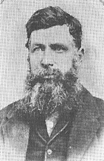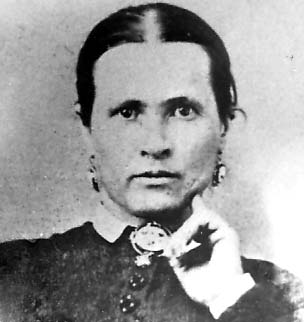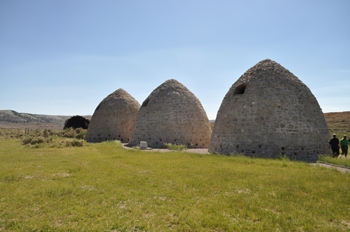12 Sep 1829 – 15 Nov 1902
Daughter of Philip Cardon and Martha Marie Tourn
Moses and Catherine Byrne, A Brief History
by Myrtle Byrne Whittaker
Moses O’Byrne, born Leftsvich, England, 1822. The O’ Byrne people were Irish, the paternal ancestors of Moses O’Byrne run back in an unbroken line for many generations in Ireland where the families were connected with agricultural activities in the “Emerald Isle”, but as my great Uncle told me that the O’Byrne people were on the wrong side of the political fence in Ireland and they moved to England where Moses was born and that when they dropped the “0” from their name they later lost a fortune from their inheritance.

Moses intermittently attended Government Schools in England until the age of sixteen, then he became apprenticed on a merchant sailing vessel, sailing the Atlantic. I have been told that Moses’ brother was Captain of that ship and that there were other younger brothers on board that this man was raising. Moses followed the seas for a number of years and had some notable adventures and narrow escapes from death, but received no disabling injuries.
Then meeting some Mormon missionaries he was converted to their religion and cast his lot with them and immigrated to America, sailing on the ship Mayflower in the year of 1854. He arrived in America and started the long overland trek to the Utah territory, and upon this trek he met a lovely young lady named Catherine Cardon
Catherine Cardon, born Sept. 12, 1829, Prarostino, Torino, Italy. Daughter of Phillipe Cardon and Marthe Marie Tourn, as Phillipe’s wife is known because Vaudois (pronounced voh dwah) women are always known by their maiden name even after marriage, and the Cardons were of that belief.

The Vaudois people were severely persecuted for many years because of their religious beliefs, many being massacred, the remnants being driven from their homes to take refuge in the Alp Mountains between France and Italy, where they subsisted for centuries as best they could, living in caves and their diets consisted mostly of barley, rye and the flesh of wild animals. They would terrace the steep rocky hills, and when the spring rains came and the run off would carry their soil down the steep hill they would then pack the soil by the basketsful up the hill and return the soil to their plots.
Once the King sent a decree to the Vaudois people, that if they would house soldiers in their homes and the soldiers were to protect the Vaudois people, then there would be peace between the Kings people and the Vaudois and there would be no more persecution. So the trusting Vaudois, with earnest hearts took the soldiers into their homes even though it worked a severe hardship on them with their meager food supplies, but early in the morning hours at a pre-arranged signal by a canon blast, the soldiers arose and slaughtered their host families with but a few surviving, with the survivors hiding in the dense forests.
Finally in 1848, under pressure from the British Government, whose good will the King wanted, King Charles Albert issued a decree granting freedom to the Vaudois and placing them on a footing of equality with other Italians and restored them to their lands in the beautiful Piedmont Valley, where upon a great feast was ordered and prepared for the Vaudois people lasting three days and nights, with great torches lighting the streets and houses, and a large parade was held and with a great show of good will the committee decided that the Vaudois people would march in front of the parade.
One day in 1852, the Mormon missionaries came to the Cardon home and daughter, Marie was greatly surprised as these were the faces of the good men that she had dreamed of earlier on. After listening and talking at great length with the missionaries the Cardon Family decided to come to the United States, mainly the Utah territory, having already joined the Mormon church, even Catherine who was governess for the Vaudois minister who had a few years before baptized her, but married daughter Anne’s husband forbade her to have anything to do with the Mormons.
Then in 1854, after selling part of their land and giving the rest to their daughter Anne, the Cardons prepared to come to America.
After crossing the high mountains by donkey, they embarked from Liverpool, England on the ship “John M. Woods” and arrived in New Orleans, La., May 2, 1854 and went by steamers up the Mississippi and Missouri Rivers to Kansas City, Missouri where they began their long trek overland to Utah territory. They, along with five other converts that Phillipe had paid passage for, arrived in October of that same year. The Cardon’s were agriculture people and soon spread out over the states of Utah, Arizona and New Mexico. The Cardons were the first ones in Utah to raise the silk worm on mulberry trees, and to make silk material. Catherine knew fine silk as soon as she touched it.
The wagon train that Moses and the Cardon family were with arrived in Utah October 28, 1854 and Moses and Catherine were married one week later. Soon after, Moses took a second wife, Ann Beus. Moses and Catherine had thirteen children and Ann had several. In later years Ann’s family moved to Idaho.
In 1861, Moses and Catherine moved to Wyoming Territory and due to a falling out with Brigham Young, Moses was excommunicated from the church. Moses built a Pony express and Overland Stage Station on the Muddy Creekthat he operated for many years, he was also commissioned to build a Pony Express-Overland Trail Station at what is now known as Point of Rock, Wyo. This station is made of native rock and is still standing and is now designated as a historical site.

Moses had to freight his supplies for his station on the Muddy from Utah. My Uncle Leslie told us that Moses rode a white mule and carried a sawed off shotgun as there robbers and avenging angels lurking in the shadows up and down Weber Canyon. The old white mule had an uncanny way of sensing or smelling out danger where upon the mule would-stop dead still with his ears pointed in the direction of the danger, so that his master never came to any harm. My grandmother told me that on the occasions he went to get supplies, Moses also visited his other wife, Ann.
To supply hay for the Pony Express horses and the livestock coming on the Overland Trail, Moses would hire a crew and go cut the natural meadows in the area.
In 1868, the railroad was coming into the area, so Moses contracted to supply ties for the railroad bed and a tent town spring up and because it was such a steep haul to the summit more engines were needed from there on so a town was started and it was called “Byrne” thought to be in honor of the Byrne family, and a deep well was drilled for the train engines and the town and a water ram pumped the water high into the water tower. But as time went by the town Byrne was confused with the terminal station Byran so the town of Byrne had to change its name. Now Catherine’s sister Marie and her husband Charles Guild had also moved to this area at the same time as Catherine and Moses, so in honor of the two sisters the town was named “Piedmont” after their valley in the old country. The word Piedmont is a French word meaning foot of the mountain.
Moses contracted to build many of the culverts in the railroad grade that are made of native stone and are still standing and in good shape.

In 1869, a small hunting party of Sioux Indians swept by and kidnapped Moses and Catherine’s two-year-old son, Eddie, from their yard and by the time it was noticed that Eddie was missing and a search party organized, the Indians and the boy were long gone. The family gave up all hope of ever seeing their son again. Moses and Chief Washakie had become great friends, Moses would always butcher a beef and give it to the tribe when they came through in the spring and Washakie’s tribe would spend quite some time in Piedmont trading and buying from the stores. Moses Byrne had a store and the Guilds had a store in Piedmont. One summer day in 1871, Chief Washakie came riding in with four-year-old Eddie astride behind him and returned him to a surprised and grateful Byrne family. Eddie was wearing Indian moccasins at the time, and in later years Eddie’s mother gave one moccasin to his sister Minnie and the other to sister Katie, each in turn handing their moccasin down to a daughter. I don’t know if Eddie had forgotten the English language in the two years that he was gone or not. Washakie would never tell Moses where or from whom he had rescued Eddie.

Moses being an enterprising man, built five charcoal kilns at Piedmont in the year of 1869, and employed 50 teams in the bringing down of the timber to be used in the kilns. The charcoal that he made was shipped by rail to ore smelters in Utah and Colorado, also the railroad used the charcoal for heating the engines, and many restaurants bought it for cooking fuel. He operated these kilns for many years. All the kilns are not standing. Many people took stones from the ones that fell. The remaining kilns are fenced in and a marker placed there and these kilns are designated a Historical site.

Moses and Catherine accumulated ranches in Piedmont, and with son Joe in Robertson, which is now owned by the Mort White’s. Son Frank settled on Thunderbolt which is now owned by Jr. Petersen.
Byrne Family Cemetry, Piedmont, WY

